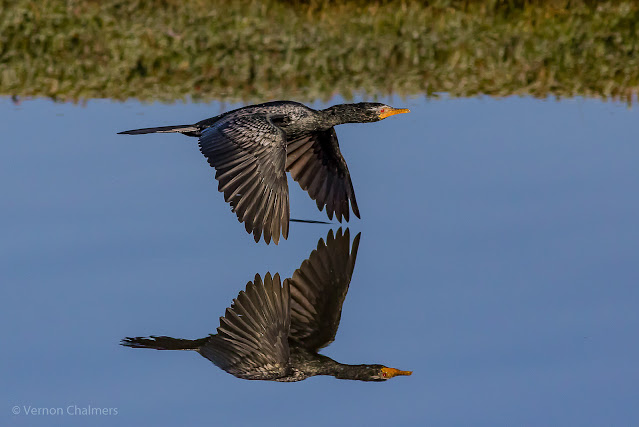 |
| Pied Kingfisher with Catch Woodbridge Island : Copyright Vernon Chalmers |
Over the past 10 years I have used more or less the same AF Settings for photographing birds in flight at Woodbridge Island, Cape Town.
Here is an overview of the Canon AF Settings (and other considerations) that I have applied with various Canon EOS APS-C and Full Frame bodies during this period.
Dual Pixel CMOS AF System / Dual Pixel CMOS AF II System
My main camera during the 10 year was the Canon EOS 7D Mark II paired with the Canon EF 400mm f/5.6L USM lens. I am very impressed with the EOS 7D Mark II's Dual Pixel CMOS AF System and the only other / best AF System I personally used apart from the EOS 7F Mark II was the Dual Pixel CMOS AF II System deployed in the EOS R6 / EOS R5 / EOS R3.
Birds in Flight Photography Image Gallery
Setup and Tips for Birds in flight Photography
 |
| Mastering Birds in Flight Photography Canon EOS / EOS R AF System Application |
- Canon EOS 700D
- Canon EOS 70D
- Canon EOS 80D
- Canon EOS 7D Mark II
- Canon EOS 6D
- Canon EOS R
- Canon EOS R6
- Canon EOS R5 Mark II
Vernon Chalmers Birds in Flight Photography Private Training theory (for Canon EOS / EOS R) are facilitated in Milnerton, Cape Town - with Birds in Flight Photography mornings-only hands-on practical sessions along the Diep River, Milnerton Lagoon and around the Table Bay Nature Reserve, Woodbridge Island. Birds in Flight Photography afternoon-only hands-n practical sessions are facilitated at Intaka Island, Cape Town. Contact me for more information.
Birds in Flight Photography Learning Objective / Training Level
For assisting the developing photographer with the understanding, exposure and application of introductory to advanced birds in flight photography.
 |
| Canon EOS 70D Autofocus Settings For Birds in Flight Photography |
Considerations for improved Birds in Flight Photography
Canon Equipment- Canon EOS 7D Mark II DSLR Camera Body
- Canon EF 400mm f/5.6L USM Lens
- Shutter speed: 1/2500 - 1/4000s
- Aperture: f/5.6 - f/6.3
- Focal length 400mm
- Auto-White Balance (AWB)
- Auto ISO (400 - 3200)
- AF Mode: Zone / Wide Zone
- AF Case: Case 1 (Default)
- AI Servo / 10fps multi-shot
- RAW processing (shooting to RAW only)
- Handheld
Canon EF 400mm f/5.6L USM Lens Setting
- Autofocus On
- No Image Stabilization
- Focal Length 400mm
- AI Servo AF Mode:** This mode is designed for continuous autofocus tracking and is essential for moving subjects like birds in flight. It continuously adjusts focus as the subject moves.
- Use Single Point or Expanded Area AF:
- Single Point AF allows precise focus control. You can select a single autofocus point and place it directly on the bird to track its movement.
- Expanded Area AF enables you to use a cluster of AF points to track and maintain focus on a moving bird more effectively.
- Case Selection for AI Servo AF:
- Some Canon models offer "Cases" that optimize AF settings for various types of movement. For birds in flight, consider using a Case that prioritizes continuous motion.
- Adjust the AI Servo Tracking Sensitivity to suit the speed and erratic movements of birds. A higher sensitivity might be necessary to track faster birds effectively.
- Customizing buttons on your camera for quick access to specific AF functions can significantly improve your workflow. Assign buttons for functions like autofocus point selection, autofocus activation, or AI Servo activation for swift changes during shooting.
- Consider using back-button focus (decoupling autofocus from the shutter button) to have more control over focusing. It allows you to focus using a button on the back of the camera, while the shutter button is solely for taking the picture.
- Combine your autofocus settings with the continuous shooting (burst) mode to capture a sequence of shots. This increases the chance of getting a perfectly focused image, especially when birds are in erratic motion.
- Each Canon camera model might have specific autofocus features and controls. Take the time to understand your camera's AF system, practice in different scenarios, and adjust settings to suit your shooting style and the behavior of the birds you're photographing.
- Canon EF 300mm f/2.8 L IS II USM Lens
- Canon EF 70-300mm f/4-5.6 IS USM lens
- Canon EF 70-300mm f/4-5.6L IS USM lens
- Canon EF 100-400mm f/4.5-5.6L IS USM lens
- Canon EF 100-400mm f/4.5-5.6L IS II USM lens
- Canon RF 600mm f/11 IS STM lens
- Canon EF 800mm f/11 IS STM lens
Birds in Flight Photography Post-Processing
Image 1: Pied Kingfisher in Flight with Canon EOS 7D Mark II / EF 400mm f/5.6L USM Lens
Image 3: Juvenile Kelp Gull in Flight with Canon EOS 70D / EF 400mm f/5.6L USM Lens
Image 4: Cape Shoveler Duck in Flight with Canon EOS R6 / RF 800mm f/11 STM Lens
 |
Canon Autofocus (AF) Setting For Birds in Flight : Grey Heron Woodbridge Island Vernon Chalmers Photography Training Intaka Island | Kirstenbosch Garden | Woodbridge Island |
